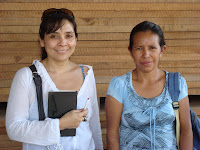 The study tour 2011 is over. It’s time to say good bye to and thank everybody who participated in many ways in the study tour. It has been wonderful to share this experience with all of you.
The study tour 2011 is over. It’s time to say good bye to and thank everybody who participated in many ways in the study tour. It has been wonderful to share this experience with all of you.In these 7 days I have learned much not only about our project partners, but also about Oikocredit members and investors and my colleagues in the region, especially Guatemala. I go back home with many thoughts in my mind: there is no perfect project but there is Oikocredit as long term partner for development. Being a social investor means creating real partnerships that go beyond financing especially in challenging times.

Guatemala is a country of challenges and hard working women and men aiming for a better future for them, their families, their communities, and their beautiful environment.






 It was nice walking in the Maya Biosphere Reserve. I am glad these communities are preserving the forest while also making a living. Thanks to sustainable forestry practices future generations would also get the chance to enjoy this beautiful environment.
It was nice walking in the Maya Biosphere Reserve. I am glad these communities are preserving the forest while also making a living. Thanks to sustainable forestry practices future generations would also get the chance to enjoy this beautiful environment.




